
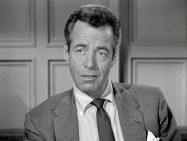 The Adventures of Philip Marlowe (1948-51) aired “The Medium Was Rare” on September 8, 1951 as the 113th of its 114 episodes. This is but the 4th episode of the show we have showcased here, the first two coming in May and December of 2020 and the third coming in late 2022. For those coming to the show for the first time I reprise the introductory background material from that initial episode.
The Adventures of Philip Marlowe (1948-51) aired “The Medium Was Rare” on September 8, 1951 as the 113th of its 114 episodes. This is but the 4th episode of the show we have showcased here, the first two coming in May and December of 2020 and the third coming in late 2022. For those coming to the show for the first time I reprise the introductory background material from that initial episode.
The original brief run starring Van Heflin debuted as a summer replacement for The Bob Hope Show from June 17, 1947 – September 19, 1947. For various reasons it didn’t wow audiences, or the creator of the character himself, Raymond Chandler, and so was cancelled, only to be retooled with a new actor as Marlowe (the incomparable Gerald Mohr, 1914-1968, photo top right) and new scripts.
Mohr was a ubiquitous figure in radio and later in television. Just a few of his more than 500 radio appearances as star or supporting character include: Jungle Jim, Archie Goodwin on The New Adventures of Nero Wolfe, The Whistler, The Shadow of Fu Manchu, Box 13, Escape, and many others. Beginning in the 1950s, Mohr appeared in more than 100 TV series during his life, among them: Maverick, The Lawman, Cheyenne, Sugarfoot, Bonanza, The Rifleman, and other Westerns. Non-western TV appearances included but were not limited to: Perry Mason, 77 Sunset Strip, Hawaiian Eye, and of SF interest episodes of Lost in Space and Voyage to the Bottom of the Sea. Of interest to comic books fans, Mohr did the voice of Reed Richards in The Fantastic Four animated cartoon series in 1967, and that of Green Lantern in the animated Aquaman series in 1968.
Conversant in Swedish, Mohr had flown to Stockholm in the Fall of 1968 to star in the pilot of a proposed television series. Shortly after filming he dropped dead of a heart attack on November 9th, 1968 at the age of 54. He was buried on the island of Lidingo, Sweden.
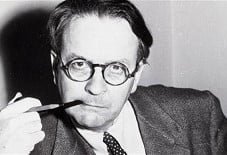 Raymond Chandler (1888-1959, photo at right) wasn’t the first to create what would come to be known as the hard-boiled detective. Dashiell Hammett was first on the scene with his Sam Spade character introduced in his 1930 novel The Maltese Falcon (first serialized beginning in the September 1929 issue of Black Mask magazine). But with Chandler’s first novel, The Big Sleep, published in 1939, he took the gritty, noir detective novel to a new level with his tough as nails private eye, Philip Marlowe. (It should be noted here that the screenplay for the classic 1946 version of the film was co-scripted by William Faulkner, Jules Furthman, and none other than SF’s own Leigh Brackett. It starred Humphrey Bogart as Marlowe and his new real life wife Lauren Bacall as Vivian Rutledge.) Marlowe’s character was not only able to handle himself on the street, he was an intellectual cut above the average gumshoe in that he had attended college, played chess, and had an ear for classical music. This side of his character only masked his off the cuff ability to fling witty descriptions and ready-made similes to pepper his
Raymond Chandler (1888-1959, photo at right) wasn’t the first to create what would come to be known as the hard-boiled detective. Dashiell Hammett was first on the scene with his Sam Spade character introduced in his 1930 novel The Maltese Falcon (first serialized beginning in the September 1929 issue of Black Mask magazine). But with Chandler’s first novel, The Big Sleep, published in 1939, he took the gritty, noir detective novel to a new level with his tough as nails private eye, Philip Marlowe. (It should be noted here that the screenplay for the classic 1946 version of the film was co-scripted by William Faulkner, Jules Furthman, and none other than SF’s own Leigh Brackett. It starred Humphrey Bogart as Marlowe and his new real life wife Lauren Bacall as Vivian Rutledge.) Marlowe’s character was not only able to handle himself on the street, he was an intellectual cut above the average gumshoe in that he had attended college, played chess, and had an ear for classical music. This side of his character only masked his off the cuff ability to fling witty descriptions and ready-made similes to pepper his 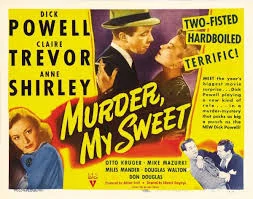 already colorful narratives, and was to become one of his trademarks, emulated by many another writer who wished to show how clever their own detective creations were. It became a widely recognized form of dialogue that later transferred itself well to the silver screen, custom made for audiences eager for the noir crime/detective experience, and was given full voice in the movie adaptation of Chandler’s 1940 novel Farewell, My Lovely. Released in 1944 under the novel’s original title in the UK, for American audiences the title was changed to Murder, My Sweet and starred Dick Powell and Claire Trevor. It was a well-received, seminal film that helped define the noir genre, and was a breakthrough role for Powell as well, who had spent a good decade or more playing the young, handsome, crooning playboy roles but never the serious leading man.
already colorful narratives, and was to become one of his trademarks, emulated by many another writer who wished to show how clever their own detective creations were. It became a widely recognized form of dialogue that later transferred itself well to the silver screen, custom made for audiences eager for the noir crime/detective experience, and was given full voice in the movie adaptation of Chandler’s 1940 novel Farewell, My Lovely. Released in 1944 under the novel’s original title in the UK, for American audiences the title was changed to Murder, My Sweet and starred Dick Powell and Claire Trevor. It was a well-received, seminal film that helped define the noir genre, and was a breakthrough role for Powell as well, who had spent a good decade or more playing the young, handsome, crooning playboy roles but never the serious leading man.
“The Medium Was Rare” opens with Marlowe packing for a vacation, a much-anticipated fishing trip.With one step figuratively outside the door he is met with a woman who frantically implores him to take her case. Marlowe denies her more than once but is soon worn down with her emotional pleadings, confident he can wrap up her case in short order and not be forced to cancel his holiday. Besides, as he remarks, he’s a sucker for dames. This is a relatively straightforward meat and potatoes case for Marlowe, for it involves $10,000 worth of stolen jewels, and is usually a routine piece of cake as his cases go. But then complications get in the way (don’t they always?) and the trajectory of the theft enters a target rich environment containing not merely the missing jewels, but dangerous ex-cons, and of all things a flesh and blood crystal ball gazing medium. So leave your hat at the door and make yourself comfortable for the next half hour as the tough as nails private eye known far and wide as Philip Marlowe cracks the case filed as “The Medium Was Rare.”
(The linked CD cover at top includes this episode and 9 others on 5 discs.)
Play Time: 29:42
{This Philip Marlowe episode aired on a Saturday evening, which meant the neighborhood gang would be heading for the nearby newsstand as soon as possible after church the next day, hunting for more stories full of danger and excitement. Dime Detective (1931-53) was the most popular and longest running of Popular Publications’detective pulps. Save for the years 1933-35 when it published two issues per month, and its final two years when its schedule tapered off, it was a monthly for almost the entirety of its existence. In 1951 it managed 7 issues. New Detective (1941-55) promised the newest in crime fiction with an emphasis on police detectives. It achieved this goal for the most part with stories from many of the field’s most popular authors. It was a bi-monthly in 1951. Other Worlds (1949-53) was published by the ubiquitous SF magazine publisher and editor Raymond A. Palmer. It was conceived as a fictional counterpart to Palmer’s non-fiction magazine Fate, which specialized in reporting on UFOs and other Unexplained phenomena. It never enjoyed a consistent schedule and when Palmer ran into financial difficulties (not a new experience for Palmer) he sold the magazine and used the money from the sale to start two new SF magazines. In 1951 Other Worlds saw 7 issues grace newsstand and bookstore shelves.}
[Left: Dime Detective, 10/51 – Center: New Detective, 8/51 – Right: Other Worlds, 9/51]
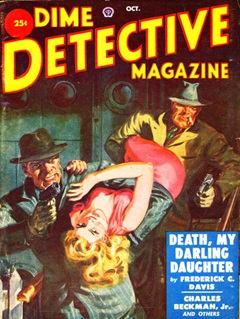
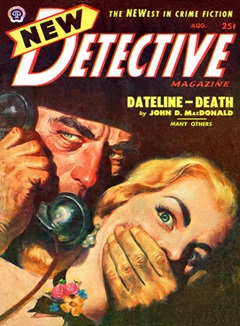
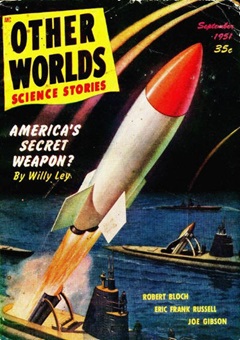
To view the entire list of Old Time Radio episodes go here.